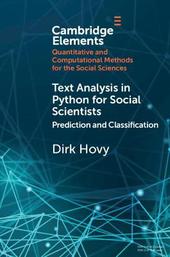
|
Text Analysis in Python for Social Scientists: Prediction and Classification
Paperback / softback
Main Details
| Title |
Text Analysis in Python for Social Scientists: Prediction and Classification
|
| Authors and Contributors |
By (author) Dirk Hovy
|
| Series | Elements in Quantitative and Computational Methods for the Social Sciences |
|---|
| Physical Properties |
| Format:Paperback / softback | | Pages:75 | | Dimensions(mm): Height 228,Width 151 |
|
| Category/Genre | Data capture and analysis |
|---|
| ISBN/Barcode |
9781108958509
|
| Classifications | Dewey:006.35 |
|---|
| Audience | | Professional & Vocational | |
|---|
| Illustrations |
Worked examples or Exercises
|
|
Publishing Details |
| Publisher |
Cambridge University Press
|
| Imprint |
Cambridge University Press
|
| Publication Date |
17 March 2022 |
| Publication Country |
United Kingdom
|
Description
Text contains a wealth of information about about a wide variety of sociocultural constructs. Automated prediction methods can infer these quantities (sentiment analysis is probably the most well-known application). However, there is virtually no limit to the kinds of things we can predict from text: power, trust, misogyny, are all signaled in language. These algorithms easily scale to corpus sizes infeasible for manual analysis. Prediction algorithms have become steadily more powerful, especially with the advent of neural network methods. However, applying these techniques usually requires profound programming knowledge and machine learning expertise. As a result, many social scientists do not apply them. This Element provides the working social scientist with an overview of the most common methods for text classification, an intuition of their applicability, and Python code to execute them. It covers both the ethical foundations of such work as well as the emerging potential of neural network methods.
|